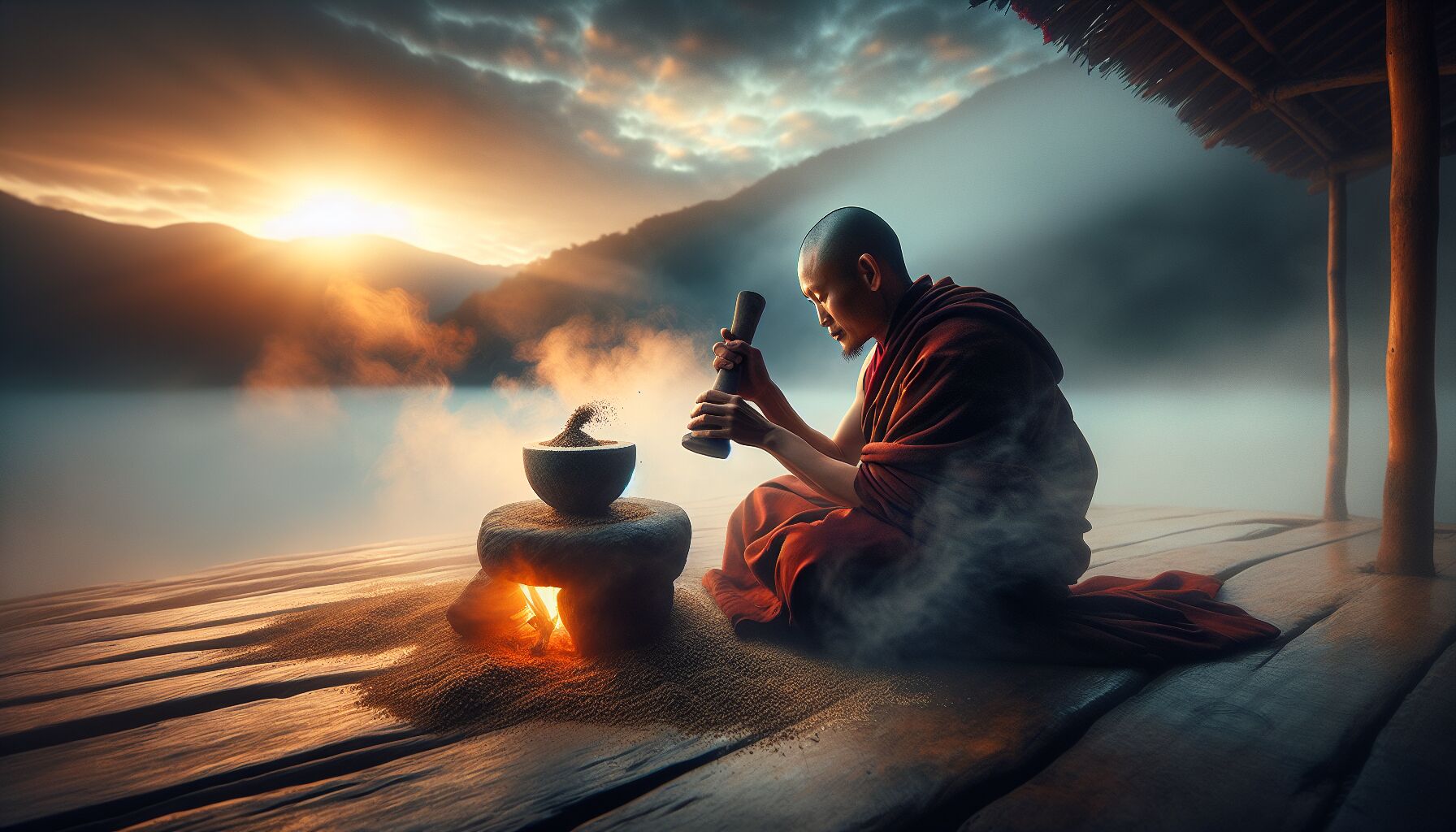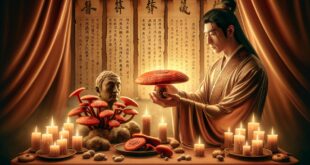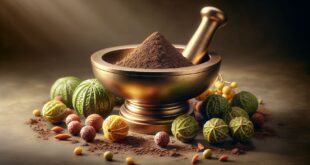 Tibetan monastic life isn’t built on escapism. It’s rooted in discipline, reverence, and a quiet precision that threads through every part of the day—from the way butter tea is stirred to how sandalwood smoke rises in meditation halls before dawn. One often overlooked cornerstone of this seemingly serene way of life? Herbs. Not as decoration, and not just for illness—but as daily companions for stillness, clarity, and deepening awareness.
Tibetan monastic life isn’t built on escapism. It’s rooted in discipline, reverence, and a quiet precision that threads through every part of the day—from the way butter tea is stirred to how sandalwood smoke rises in meditation halls before dawn. One often overlooked cornerstone of this seemingly serene way of life? Herbs. Not as decoration, and not just for illness—but as daily companions for stillness, clarity, and deepening awareness.
These monks weren’t picking random weeds off a hillside and calling it wisdom. What they cultivated was based on thousands of years of Tibetan medicine, which blends Ayurveda, Chinese pharmacology, and indigenous Himalayan plant lore. It’s staggeringly complex—yet grounded in observation, experience, and a profound relationship with land and body.
Herbs were never just “supplements;” they were spiritual tools. Grown in the shadowed valleys of the Himalayas or collected from sun-cracked cliffsides at unbearable altitudes, each root or flower came with meaning. Rhodiola, for example—a now-famous adaptogen—was known to monks for offering stamina during their long hours of fasting and high-altitude chanting. More than energy, though, it helped with what we’d now call cognitive health. It kept the mind present.
Their use of plants wasn’t theoretical. They boiled, sun-dried, and hand-ground their harvests into powders and teas as part of rigorous study and practice. Formulas were passed down directly from teacher to student—not just textually, but embodied. Taste mattered. Timing mattered. Even silence, during preparation, had a role. Was it superstition or mindfulness? In their world, that was a false distinction.
“Tibet’s sages didn’t see healing as separate from knowing. They didn’t split medicine from meditation.” — Dr. Pasang Yonten Arya, scholar of traditional Tibetan medicine
And here’s something—Tibetan monks didn’t always wait for the body to fall out of balance before reaching for herbs. Instead, many herbs were incorporated proactively into a monk’s seasonal routine. Think of it like tuning a string instrument before the performance begins. If winter brought sluggish digestion and foggy thinking, then warming roots and bitter tonics were introduced. Springtime? More aromatic barks and greens to wake up the liver and eyes.
“Preventing illness before it arrives is true medicine. Fighting after—it’s already war.” — Tibetan proverb
There’s a straight-backed practicality to the way they approached this. No wasting energy chasing after peak productivity or oversized expectations. But neither did they indulge in spiritual fantasy. Herbs, prayer, sleep, breathwork—it was all part of the same thread. Efficient, quiet, remarkably consistent.
What’s worth noting, for those walking modern paths of healing or spiritual growth, is that their model steered away from one-size-fits-all fixes. While modern adaptogens like ashwagandha or holy basil earn plenty of attention (sometimes rightfully so), Tibetan monks understood the importance of energetics—the “temperature” of a herb, its movement, its subtle influence on different constitutions. It’s intuitive in one sense, but also empirical. Even now, schools like Men-Tsee-Khang—the official institute for Tibetan medicine—are training physicians to maintain this exacting balance between science and tradition. You can browse their teachings here. Nothing “New Age” about it.
Let’s not forget the spiritual aspect, though not in a performative way. The use of these herbs wasn’t detached from intention. A monk didn’t just pop a pill and wait for clarity to descend. The act of growing, preparing, sipping—each step reinforced the neural pathways of awareness, acceptance, and responsiveness. That’s how plant allies really work. Not as magic bullets, but as partners in stillness.
So, ask yourself: what would change if your tea cabinet served not just your body, but your awareness? If your daily sips helped your mind stay softer, but sharper?
That’s the kind of intelligence monks were nurturing—not speed, not force, but presence that could withstand noise. Their herbal tradition wasn’t about enhancement. It was about remembering the mind’s natural state—quiet, capable, and awake. Not always easy in this distracted age—but maybe, quietly possible.
Key herbs used for enhancing focus and clarity
You won’t find these herbs in flashy packaging on a grocery endcap, and certainly not brewed into trendy energy shots. The plants Tibetan monks relied on were often bitter, earthy, sometimes pungent—hardly the easy sells. But that tells you something, doesn’t it? These herbs weren’t chosen for comfort. They were chosen for results: better focus, a calmer baseline, and resilience during intensive meditation or teaching cycles. In other words—support for real inner work.
Let’s start with Rhodiola rosea. It’s arguably the most well-known of Tibetan adaptogens, and for good reason. Known locally as “golden root,” Rhodiola thrived in rocky, high-altitude environments where oxygen thins and attention wanes. Monks traditionally used it when prolonged chanting or fasting demanded sharpness without agitation. Today, studies confirm it can reduce fatigue and promote cognitive performance under stress. But here’s what matters more: Rhodiola isn’t about hype—it’s about lowering the noise in the nervous system so clarity has a room of its own.
Then there’s Schisandra—a less talked-about berry with five flavors: sweet, sour, salty, bitter, and pungent. This complexity made it particularly prized in Tibetan medicine, where the concept of flavor isn’t just taste—it signals what the plant does in the body. Schisandra was often taken in the morning to support memory retention and structured thinking on study days. Imagine ten hours of deciphering dense scriptures and syllabic mantras—you’d want your mind fully zipped into place. Modern herbalists call Schisandra an adaptogen too, but to monks, its value was spiritual discipline made visible. It anchored focus without sacrificing calm.
“Pay attention to how a plant moves in you—not just what it fixes.” — Tashi Rabten, student of Tibetan pharmacology
Then there’s the overlooked but potent Gotu Kola—called “the herb of enlightenment” in both Tibetan and Indian traditions. While not native to Tibet’s high plains, it traveled into monastic centers via trade and pilgrimage routes. Monks used it during intensive visualization practices, likely because of its grounding-yet-lifting quality. From a modern lens, Gotu Kola boosts circulation to the brain and supports long-term memory—crucial for those memorizing thousands of verses by heart. It’s less about caffeine-like stimulation and more like widening the vessel. Bigger container, steadier mind.
So why don’t we hear about these herbs more often, especially among mindfulness circles? Probably because they require consistency. They ask for relationship, not a one-and-done use. Modern consumers—raised on quick fixes—often move on if they don’t feel something “kick in” within 20 minutes. But the monks weren’t chasing jolts. They were building a sustained hum of awareness, and herbs were simply one part of that mosaic.
Let’s also be honest—it wasn’t just what the monks took, but how. A powerful herb thrown into a distracted, fried-out system won’t yield clarity—it’ll likely stir the pot. The cultural context matters. A monk sitting in silence steeping Rhodiola tea at dawn? That’s very different than someone scrolling social media while chugging the same herb to muscle through emails.
That’s not to say these plants can’t help the modern mind—they absolutely can. But they work better when we approach them with the same ethic of intentionality. Instead of stacking five adaptogens hoping for a miracle, what if we started with just one—prepared slowly, taken mindfully, observed like a craftsman watches water boil?
Of course, no Tibetan apothecary would be complete without holy basil (Tulsi). While more prominent in Ayurveda, Tulsi found its way into temple compounds across the Himalayas, especially during seasonal transitions. Its sharp, peppery fragrance helped lift morning fog—literal and mental. Tibetan monks preferred it in combination with black cardamom or aged ginger for digestion and clarity. Fun fact: its role as a sattvic herb—meaning it promotes lucid, peaceful states—aligned beautifully with cognitive health goals, especially during prayer recitations that extended past midnight.
And let’s not forget nutmeg. Surprised? Used sparingly and in combination with ghee or milk during preparation, nutmeg was believed to calm overactive thinking—particularly helpful when mental focus tipped into obsession or insomnia. It wasn’t used daily, but as needed, like an herbal bookmark between chapters of mental overload.
In this whole framework, herbs don’t overpower—they cooperate. They gently nudge energy where it’s meant to go. And that’s the subtle genius of Tibetan medicine: better slow and steady than fast and noisy. When focus is built like a fire—gradual, hot, and tended—it sustains you longer.
A closing thought from someone who walked no monasteries, but still understood the practice:
“Clarity does not always come from adding more light, but when the fog finally disperses.” — David James Duncan
The monks got that. And their herbs—quiet allies with deep roots—weren’t miracle cures. They were, and still are, invitations: to be here, fully. Not hyper. Not numb. Just alert, at peace, and finally able to listen.
Rituals and practices integrating herbal remedies
 Let’s be clear about something—herbs in Tibetan monastic life were never meant to stand alone. They weren’t miracle powders for monks too tired to meditate. They were integrated, carefully and intentionally, into the rhythm of disciplined living. Wake before the sun. Tend the fire. Wash. Sit. Sip. Recite. You can almost hear the pulse of it. Ritual. Habit. Practice.
Let’s be clear about something—herbs in Tibetan monastic life were never meant to stand alone. They weren’t miracle powders for monks too tired to meditate. They were integrated, carefully and intentionally, into the rhythm of disciplined living. Wake before the sun. Tend the fire. Wash. Sit. Sip. Recite. You can almost hear the pulse of it. Ritual. Habit. Practice.
This isn’t romanticism—it’s routine, and routine is where the real work begins.
Take tea, for instance. Not in the casual, modern sense of a self-care mug on a work break, but as a spiritual protocol. The first cup of the day often contained herbs like Rhodiola or Gynostemma, sometimes fused with roasted barley or yak milk. It wasn’t just for warmth. It grounded the body before long bouts of visualization or whispered recitation. Why whisper? It trains the mind to stay awake without loud input—a training in restraint.
These herbal infusions were taken sitting in full presence. Eyes soft. Spine upright. No screen in hand. No podcast playing in the background. This wasn’t multitasking—it was mono-intending. Letting the herb’s energy become a companion to the practice ahead.
“When drinking tea, just drink tea. When sitting, just sit.” — Zen proverb (but the sentiment ran deep in Tibet too)
The preparation mattered too. Herbs were weighed by hand, not estimated blindly. In some monasteries, it was a designated responsibility—intended to be an honor, not a chore—to grind and mix formulas for the week ahead. The process started with silence, then intention, then fire. The same tea house that prepared sacred medicines might also prepare offerings for deities, so the boundary between healing and reverence blurred naturally.
And sure, not every cup was ceremonial. Some herbs were taken more casually—blended with tsampa (roasted barley flour) or stirred into broths. But even then, there was mindfulness. Timing followed the body’s rhythms, not convenience. You wouldn’t take a stimulating adaptogen like Rhodiola late at night any more than you’d try to meditate after eating fried dumplings. Tibetan medicine teaches that the quality of awareness changes with what you consume—and when. Overstimulated digestion equals overstimulated thought. Simple.
Then there were days built entirely around herbal protocols. During peak retreat periods, or lhabab düchen (a sacred festival marking the Buddha’s descent from heaven), monks might reduce food and increase tonifying herbs like astragalus or licorice root to maintain vitality during silence. These weren’t extreme cleanses or punishing austerities. They were ancient strategies for sustaining mental clarity without burning out the nervous system.
One powerful example? Herbal facials and steam baths. Yes—monks used them not for vanity, but purification. Mugwort and juniper were boiled in massive stone pots, creating a dense, fragrant fog. The purpose? Clear the sinuses, open the lungs, revive the senses. Useful before complex chanting or multi-day readings. It called the spirit back into the body.
“Medicine in our lineage does not treat the body separate from the windhorse.” — Oral Teaching, Nyingma lineage
“Windhorse” (lungta, in Tibetan) refers to spiritual momentum, a kind of vital force that bridges body and mind. Many herbs used by monks were aimed not just at cognitive health, but at protecting this energetic clarity. Overstimulate it, and you get anxiety. Suppress it, and you get fog. Rituals helped balance this fine line.
And let’s talk movement. While seated meditation was central, Tibetan practice also included yogic disciplines like trul khor—a predecessor to modern breath-and-posture systems. Herbs were taken to support these physical practices. For example:
- He Shou Wu for joint fluidity and energy during long holds
- Astragalus when immunity and breath needed support at elevation
- Myrobalan (one of the three fruits in Triphala) to aid in cleansing for deeper concentration
None of these steps were considered separate from practice. The herb wasn’t “prep” for meditation. The drinking of the herb, the grinding, the movement and breath—it was all the meditation.
Honestly, this is where so many modern “biohacking” attempts fall flat. We throw adaptogens into smoothies while glued to screens, hoping brain fog will vanish like smoke. But without regularity and attention, even the finest tonic becomes just another distraction. Without stillness, plants can’t teach us anything.
Here’s a question worth asking: What if every daily ritual—even one cup of tea—could be a rehearsal for deeper listening? Not just getting things done, but being more deeply here.
That’s the thread Tibetan monks kept alive. Their rituals weren’t about doing more. They were about doing just enough—with immense intention. And the herbs? They came quietly, supporting that work from deep within—never forcing, always guiding.
So maybe herbs won’t fix everything. But inside a structure of breath, stillness, movement, and practice? That’s where their real magic shows up.
Not as cures. As companions.
 DS Haven In Light Of Things
DS Haven In Light Of Things





